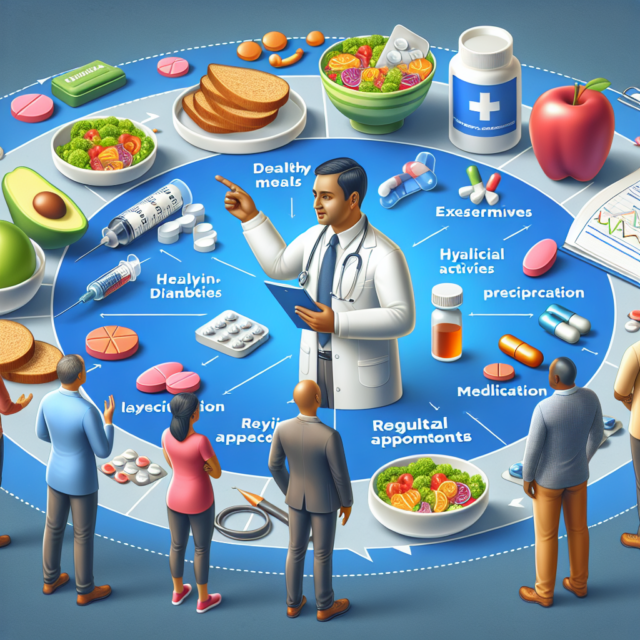Managing Type 2 diabetes effectively can be challenging, but it’s also essential for improving patient outcomes. With the right strategies, healthcare providers can empower their patients to lead healthier lives, reducing complications and enhancing quality of life. This guide provides an overview of comprehensive management approaches, from medication choices to lifestyle changes, tailored for doctors and healthcare professionals who work in diabetes care.
Understanding Type 2 Diabetes
Type 2 diabetes is a chronic condition characterized by insulin resistance and an eventual decline in insulin production. It affects millions of patients worldwide, often coexisting with other health issues like obesity, hypertension, and dyslipidemia. For healthcare professionals, managing this condition effectively requires a multi-faceted approach that addresses both the physical and lifestyle components of the disease.
Goals of Type 2 Diabetes Management
The primary goal in managing Type 2 diabetes is to control blood glucose levels within target ranges while preventing complications. By reducing A1C levels and promoting overall metabolic health, we can help patients improve their day-to-day functioning and long-term prognosis. This requires personalized, patient-centered care.
Initial Assessment and Diagnosis
When diagnosing Type 2 diabetes, an initial assessment is crucial to determine the patient’s baseline health status. Important evaluations include fasting blood glucose, A1C levels, and a lipid panel. Once diagnosed, assessments help establish individualized treatment plans that are responsive to the patient’s lifestyle, health needs, and preferences.
Lifestyle Changes: The Foundation of Management
Lifestyle changes remain a cornerstone of Type 2 diabetes management. For many patients, adjusting daily habits can have a profound impact on glucose control. Education around diet, exercise, and behavioral modifications should be a consistent part of each treatment plan.
Diet and Nutrition Recommendations
Diet plays a critical role in managing diabetes. Encourage patients to focus on nutrient-dense foods, particularly those that support steady blood sugar, like high-fiber vegetables, whole grains, lean proteins, and healthy fats. Low-carbohydrate diets and portion control are beneficial in managing postprandial glucose spikes.
The Role of Exercise
Physical activity helps increase insulin sensitivity and improve blood glucose control. For patients, encourage moderate exercise like walking, cycling, or strength training for at least 150 minutes a week. Even small amounts of physical activity can provide substantial benefits for glucose control and cardiovascular health.
Medication Options for Type 2 Diabetes
A variety of medications are available to manage Type 2 diabetes, and choosing the right one involves considering factors such as efficacy, patient preferences, and potential side effects. Medications can range from oral agents like metformin to injectables such as GLP-1 receptor agonists and insulin.
Using Metformin Effectively
Metformin remains the first-line treatment due to its efficacy, low cost, and relatively mild side effect profile. It works primarily by decreasing hepatic glucose production and enhancing insulin sensitivity. For patients experiencing gastrointestinal discomfort, starting with a low dose and gradually increasing it can improve tolerability.
Incorporating GLP-1 Receptor Agonists
GLP-1 receptor agonists (e.g., Ozempic, Trulicity) not only lower blood glucose levels but also offer weight loss benefits, which is advantageous for many Type 2 diabetes patients. These medications have shown cardiovascular protective effects, making them an excellent option for patients with heart disease.
SGLT2 Inhibitors: Cardiovascular and Renal Benefits
SGLT2 inhibitors (such as Jardiance and Farxiga) have gained popularity for their dual benefits on glucose control and cardiovascular health. They reduce glucose reabsorption in the kidneys and are associated with lowered risks of heart failure and renal disease progression, making them a valuable option for high-risk patients.
Insulin Therapy: When to Initiate
Insulin therapy is often reserved for patients with advanced Type 2 diabetes or when oral medications and lifestyle changes are insufficient. Starting insulin can be intimidating for patients, so emphasizing its role as a supportive tool rather than a “last resort” can encourage acceptance and adherence.
Monitoring Blood Glucose Levels
For patients, regular blood glucose monitoring is essential for understanding how diet, exercise, and medications affect their levels. Newer technologies, such as continuous glucose monitors (CGMs), offer real-time data and can improve patient engagement in self-management, particularly for those requiring more intensive monitoring.
Addressing Patient Barriers to Management
Patient adherence can be one of the most challenging aspects of Type 2 diabetes management. Common barriers include fear of needles, medication costs, and lifestyle factors. Address these openly with patients, offering guidance and resources to help overcome these obstacles.
Reducing the Risk of Complications
Preventing complications is key to long-term management. Regular screenings for neuropathy, retinopathy, and nephropathy are essential, as early detection allows for interventions that can prevent or slow progression. Educate patients on the importance of foot care, regular eye exams, and annual lab tests.
Conclusion
Managing Type 2 diabetes is a complex but rewarding endeavor. For healthcare professionals, using a comprehensive approach that combines lifestyle changes, effective medications, and patient-centered education can make a real difference in patient outcomes. By prioritizing patient engagement and addressing barriers, we can support patients in leading healthier, more fulfilling lives.
FAQs
1. What is the first-line medication for Type 2 diabetes?
Metformin is typically the first-line treatment due to its effectiveness, safety profile, and affordability.
2. How do GLP-1 receptor agonists help manage Type 2 diabetes?
GLP-1 receptor agonists improve glucose control and support weight loss, with additional cardiovascular benefits for certain patients.
3. When should insulin therapy be initiated in Type 2 diabetes?
Insulin is often introduced when oral medications and lifestyle adjustments are insufficient to control blood glucose levels.
4. How important is diet in managing Type 2 diabetes?
Diet is critical, as nutrient-dense, low-glycemic foods help stabilize blood sugar and improve overall health outcomes.
5. Are SGLT2 inhibitors suitable for all Type 2 diabetes patients?
SGLT2 inhibitors are particularly beneficial for patients with cardiovascular risks or kidney issues, but they may not be suitable for everyone. Consult a healthcare provider.


